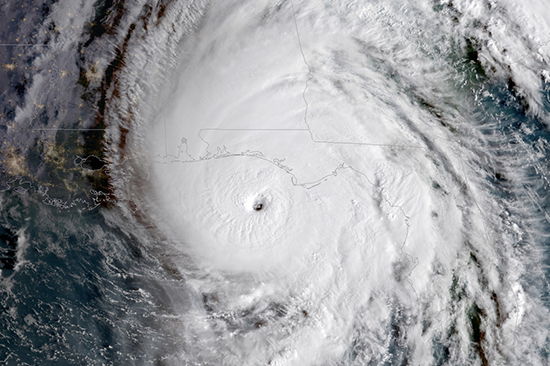Atmospheric Scientist Leads $2 Million Project to Study Hurricane Intensity
 |
|
NOAA Satellite image of Hurricane Michael making landfall along the Florida Panhandle in 2018. |
ALBANY, N.Y. (Jan. 30, 2020) – UAlbany atmospheric scientist Brian Tang has been awarded $2.145 million from the Office of Naval Research (ONR) to help forecasters better understand and predict the rapid intensification of hurricanes.
Current hurricane models do not typically forecast rapid intensification well, according to Tang. This is due to, he said, three complex processes at play: the environment around a hurricane; thunderstorm clouds within a hurricane; and small-scale turbulent motions between the ocean and clouds.
His goal is to examine how these processes are working together, guiding improvements in hurricane forecast modeling.
“To borrow a phrase from the great American astronomer Carl Sagan, hurricanes are a microcosm of the ‘awesome machinery of nature.’ Understanding how this machinery works in a hurricane, particularly ones that rapidly intensify, drives me as a researcher studying these storms,” said Tang, an associate professor in the University’s Department of Atmospheric and Environmental Sciences (DAES).
 |
|
DAES Associate Professor Brian Tang. |
“Rapidly intensifying hurricanes can pose a grave threat to coastal communities,” he added. “There have been a number of instances where hurricanes have rapidly intensified in the day or two before landfall, such as Hurricane Michael in 2018, resulting in escalating dangers to coastal communities and leaving little time to react.”
Tang is teaming up with the National Center for Atmospheric Research and the University of Miami over the next five years to conduct the research. DAES Professor Robert Fovell is collaborating as a co-principal investigator.
With ONR’s support, the group will look at rapid intensification through several lenses. This includes a comparison of past hurricanes that were in similar environments and had similar characteristics, but differed in intensification, and then running computer simulations to study processes leading to rapid intensification. The simulations will be run at an ultra-high resolution, 10- to 30-times higher than current hurricane forecast models.
In addition, the group plans to be involved in an ONR field project to collect data from inside hurricanes using reconnaissance aircraft. They will also be recruiting graduate students and postdoctoral research associates to join the research team.
“Accurate hurricane intensity forecasts are critical to resiliency and preparedness,” Tang said. “It is our hope that this research will help improve forecasts of hurricane intensification, so that emergency managers, government officials, the military, and the public may make more informed decisions ahead of threatening hurricanes.”
You can learn more about Tang by visiting his UAlbany expert page.
![]() For more news, subscribe to UAlbany's RSS headline feeds
For more news, subscribe to UAlbany's RSS headline feeds
A comprehensive public research university, the University at Albany-SUNY offers more than 120 undergraduate majors and minors and 125 master's, doctoral and graduate certificate programs. UAlbany is a leader among all New York State colleges and universities in such diverse fields as atmospheric and environmental sciences, business, education, public health,health sciences, criminal justice, emergency preparedness, engineering and applied sciences, informatics, public administration, social welfare and sociology, taught by an extensive roster of faculty experts. It also offers expanded academic and research opportunities for students through an affiliation with Albany Law School. With a curriculum enhanced by 600 study-abroad opportunities, UAlbany launches great careers.


